Key takeaways:
- Creative mediums each offer unique ways to express ideas and emotions, with understanding their strengths enhancing artistic output.
- Integrating different mediums, such as visual art and sound, can deepen storytelling and broaden audience engagement.
- Experimentation and collaboration across various forms can lead to innovative projects that evoke emotional and relatable experiences.
- Overcoming challenges in integration requires vulnerability, communication, and patience, ultimately fostering personal growth and creative development.
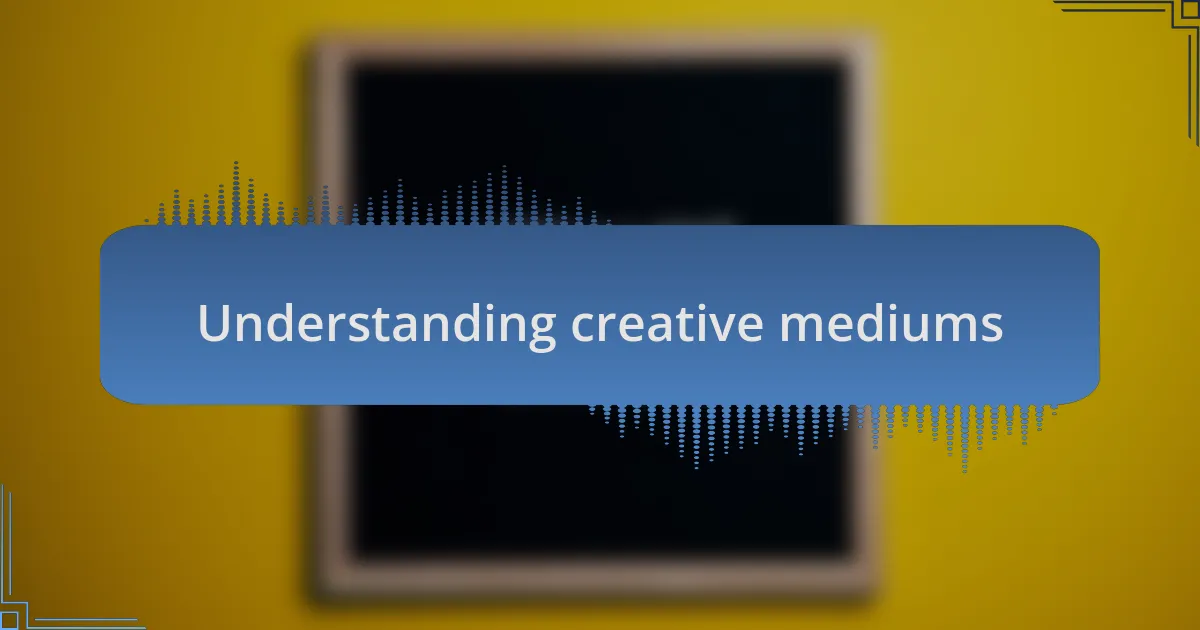
Understanding creative mediums
Creative mediums are the various forms through which we express our ideas and emotions. Whether it’s painting, photography, digital design, or writing, each medium offers a unique lens through which we can view the world. I often find myself wondering how different mediums can change a single idea. For instance, the feeling of nostalgia can emerge differently in a photograph compared to a poem. Have you ever noticed how the same theme can resonate more deeply in one form than another?
When I first dabbled in mixed media art, I was amazed at how combining photography and paint could create layers of meaning I hadn’t anticipated. Each layer added its own texture, both physically and emotionally, giving the piece a richer story. This experience made me realize that understanding the strengths and limitations of each medium can significantly enhance our creative output. Are there particular mediums that make you feel more connected to your work?
As we explore these creative avenues, it’s essential to acknowledge that no medium is inherently superior to another. Each has its own voice and purpose, allowing us to communicate differently depending on what we’re trying to convey. I believe that recognizing these subtleties can transform our creative practices, leading to a more fulfilling exploration of our ideas. It makes me curious about how you choose your mediums and what stories they help you tell.
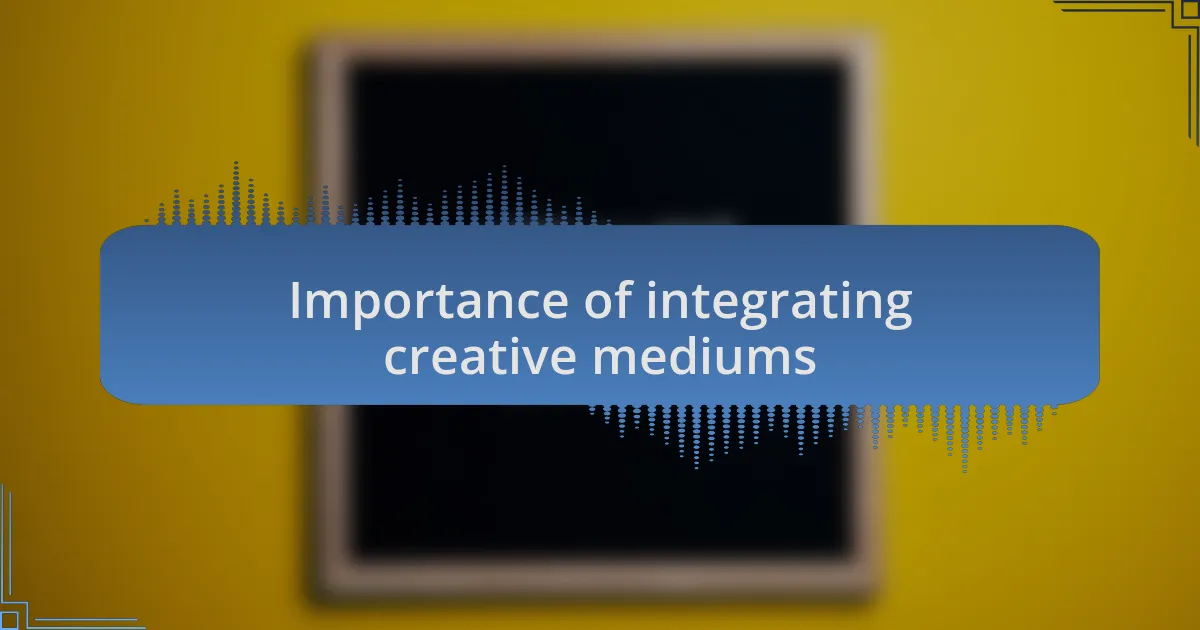
Importance of integrating creative mediums
Integrating different creative mediums can fundamentally change the way we approach storytelling. I once collaborated with a musician to create a visual album, where each track inspired a distinct piece of artwork. This process revealed how a simple melody could evoke a completely different emotional response when paired with contrasting visuals. Have you ever considered how the synergy between sound and imagery might transform your own projects?
When I experimented with combining graphic design and poetry for a personal project, I realized that the interplay of visual and literary elements can amplify meaning beyond what words or images can convey alone. The poem took on new life through the colors and shapes I chose, igniting a deeper connection with my audience. Isn’t it fascinating how blending various mediums can offer new dimensions to our ideas?
Moreover, diverse creative mediums cater to different learning styles and preferences, making our work accessible to a wider audience. For instance, I often find that a video tutorial can complement written instructions, catering to both visual and auditory learners. This adaptability not only enriches the experience for others but also challenges us to think outside the box. Have you noticed how using multiple mediums can help you reach more people in your creative endeavors?
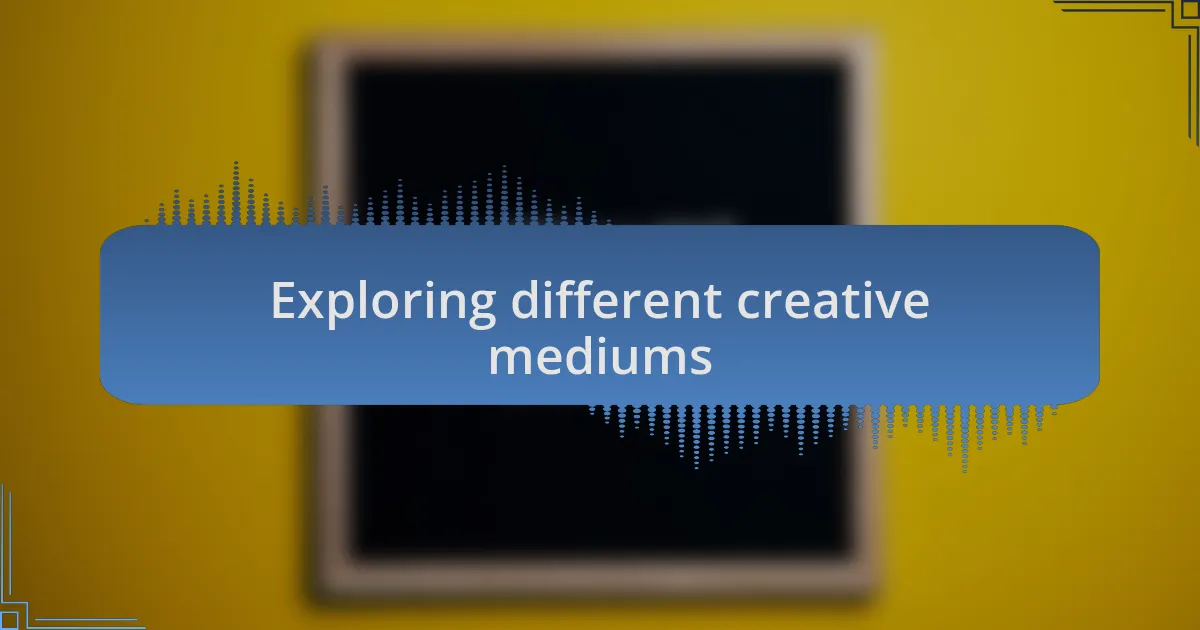
Exploring different creative mediums
Exploring different creative mediums has always intrigued me. On one occasion, I collaborated on a community mural that incorporated poetry and artistic painting. The raw words, scrawled alongside vibrant colors, created a visceral experience for passersby. I remember feeling the thrill as people stopped to read the verses, connecting emotionally with the art as they navigated their daily routines. Isn’t it amazing how creativity can engage both the mind and heart simultaneously?
Another time, I delved into combining photography and cooking, creating a blog that featured recipes framed by stunning visuals. Each dish became a story, not just through ingredients but also through the lens capturing colors and textures that enticed the viewer’s appetite. This fusion allowed my audience to not only learn how to cook but also to feel inspired by the beauty of everyday meals. Have you tried merging your hobbies in unexpected ways like this?
In my experience, experimenting with creative mediums urges us to step outside our comfort zones and consider new perspectives. For instance, developing an interactive website that combined audio snippets with varying art styles encouraged visitors to engage fully with the content. The blend of auditory and visual elements kept them immersed, leaving a lasting impression. It’s a powerful reminder that creativity knows no boundaries—what new combinations are you curious to explore in your work?
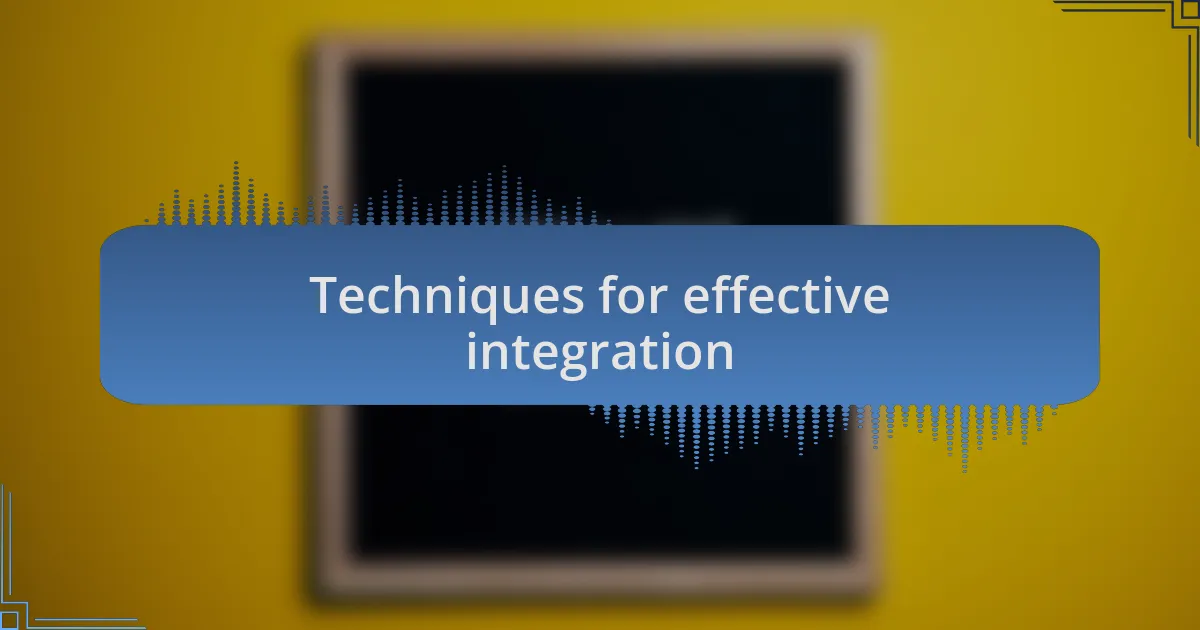
Techniques for effective integration
When considering techniques for effective integration, I often reflect on the power of storytelling through multiple mediums. For example, while curating a photography exhibit, I paired each image with an audio narrative from the subjects themselves, sharing their experiences. This synergy created a richer understanding and emotional connection for viewers—don’t you think hearing a story enhances the visual impact?
I also find that maintaining a cohesive theme is crucial for integrating different elements. During a recent art project, I focused on sustainability, blending recycled materials with digital illustrations. This deliberate choice not only unified the pieces but also sparked conversations about environmental responsibility. Have you ever noticed how a well-chosen theme ties together seemingly disparate elements, creating a deeper impact?
Experimentation with format can lead to inspiring integrations as well. I once developed a workshop that combined live painting with music performances, allowing participants to experience art in real-time as it evolved. The spontaneity of this fusion not only captivated the audience but also shifted their perception of both art forms, illustrating how creative boundaries can be blurred. What unique formats have you experimented with in your own work?
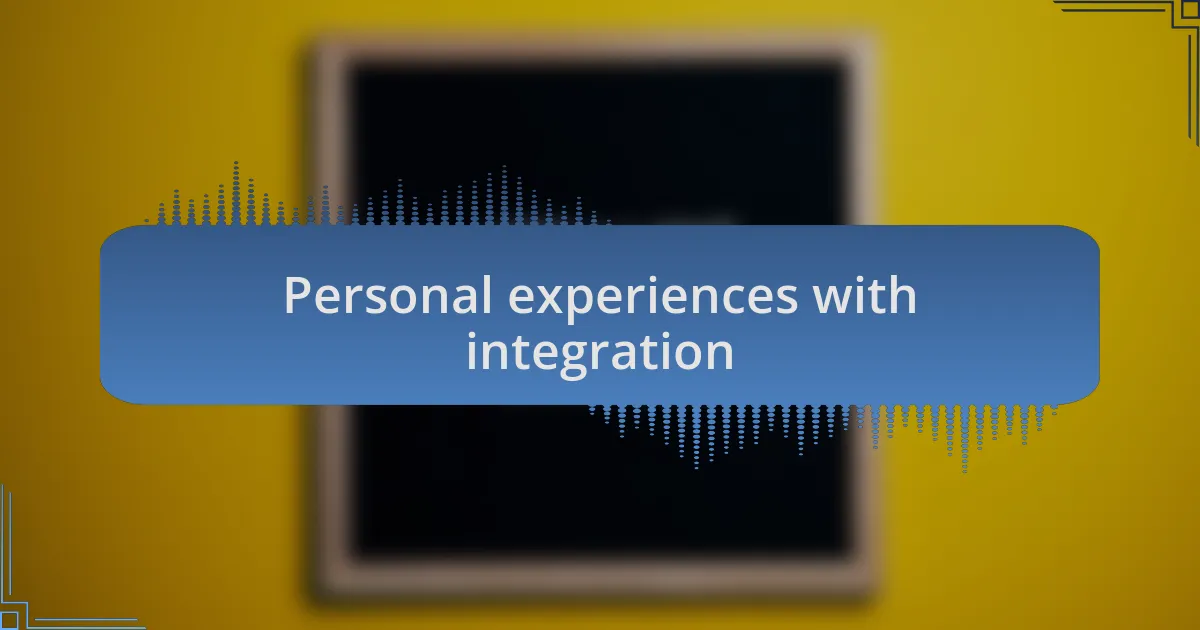
Personal experiences with integration
Reflecting on my journey of integrating different creative mediums, I recall a heartfelt project where I collaborated with dancers and visual artists. We choreographed a performance that involved live painting, allowing the audience to witness the creation of art as it unfolded alongside the dance. This blending of movement and color was not just visually stunning; it evoked such an emotional response in viewers. Have you ever felt that rush when art is truly alive in a performance?
Another memorable experience was when I created an interactive exhibition that invited visitors to contribute their own stories. I set up a digital wall where attendees could submit short videos about their experiences while viewing the artwork. The result was a tapestry of perspectives that transformed the exhibit into a communal space. Isn’t it fascinating how engaging the audience can shift the narrative and make art more relatable?
Moreover, I often experiment with diverse art forms to push creative boundaries. I recently hosted a fusion event that combined poetry readings with live soundscapes. Seeing how the rhythm of the spoken word intertwined with ambient music brought both elements to life in a way I hadn’t anticipated. It made me wonder: how might we continue to expand our creative dialogues through such collaborations?
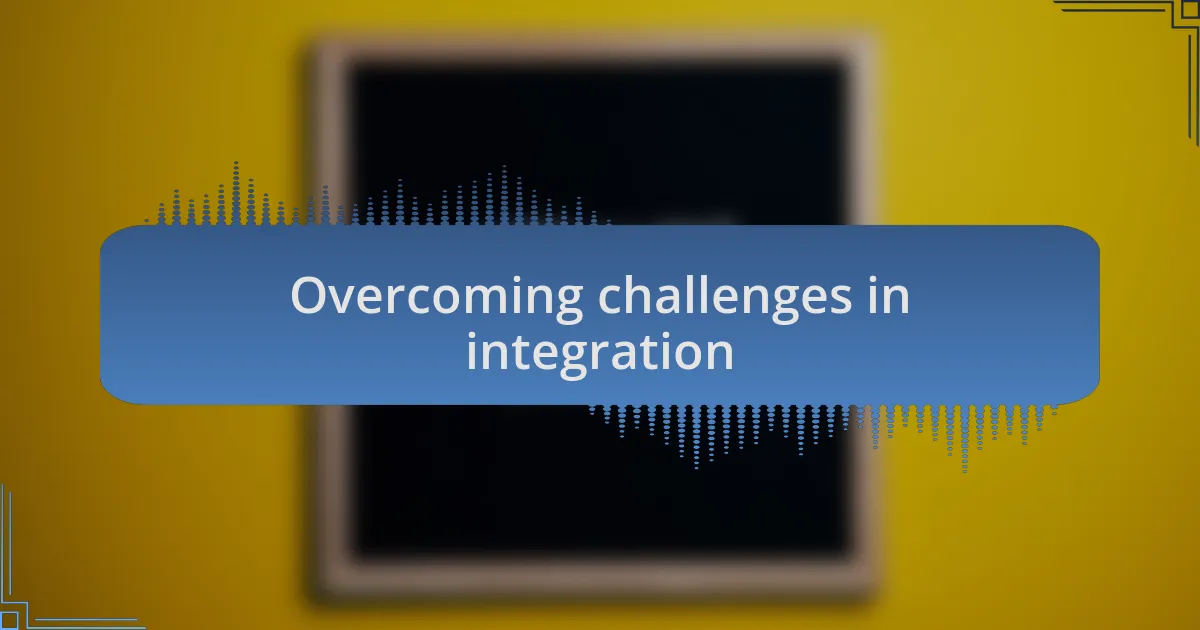
Overcoming challenges in integration
Navigating the challenges of integrating different creative mediums can often feel daunting, yet I’ve found that embracing vulnerability helps to foster collaboration. During one project, I faced resistance from a team member who was hesitant to merge their sound design with my visual elements. By sharing my insecurities about the process, we found common ground and ultimately enhanced each other’s work. Have you encountered similar hesitations in your creative collaborations?
Communication is another key factor in overcoming integration hurdles. I recall a time when I was working with a group of graphic designers and writers on a marketing campaign. Initially, our visions clashed, leading to frustration. However, facilitating open discussions where everyone could voice their ideas allowed us to blend our perspectives seamlessly. It was amazing to witness how those conversations sparked innovative solutions, reigniting our enthusiasm for the project.
In my experience, patience is crucial while integrating diverse creative elements. I vividly remember struggling with timing during a multimedia performance, where syncing video projections with live music was proving to be a challenge. We had to rethink our approach multiple times, which was frustrating in the moment, but eventually led to a more dynamic performance that exceeded our original vision. How has patience played a role in your creative processes?
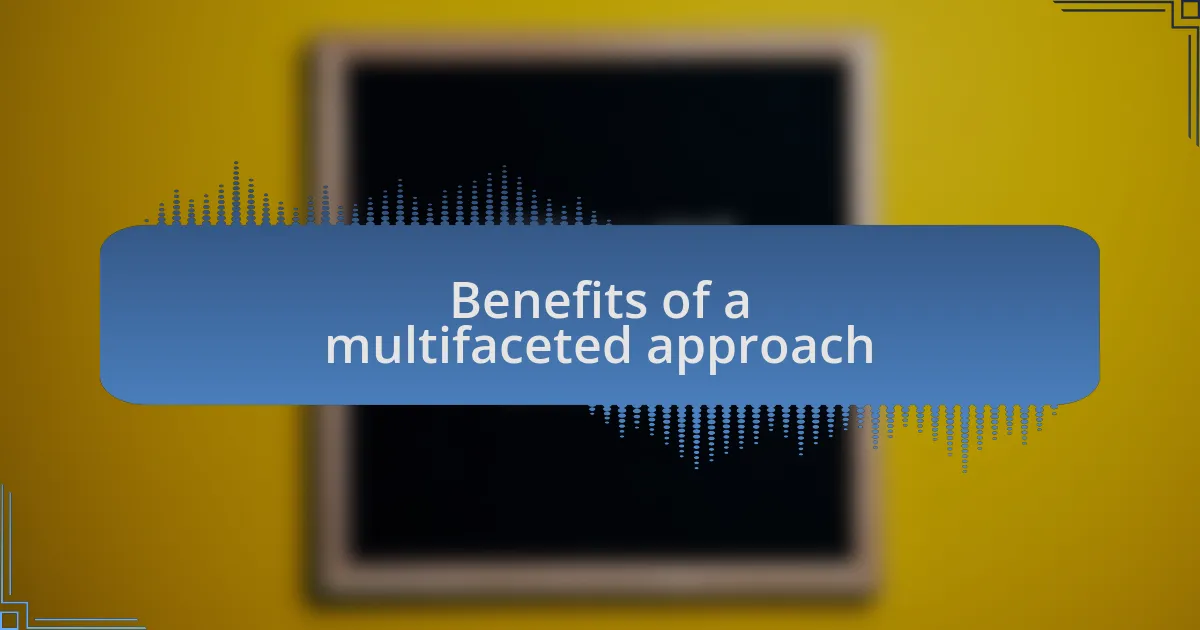
Benefits of a multifaceted approach
Integrating various creative mediums opens up a world of possibilities. I remember when I combined photography with digital animation for a gallery exhibit. The results were beyond my expectations, creating an immersive experience that drew viewers deeper into the narrative. Have you ever tried blending different art forms? It can lead to unexpected innovations that surprise even the creator.
A multifaceted approach also fosters inclusivity and diversity in creativity. When I collaborated with musicians and visual artists for a community project, I was struck by how our unique perspectives enriched the final piece. Each contribution added a layer of depth, creating a work that resonated with a broader audience. Isn’t it fascinating how our differences can come together to create something truly special?
Moreover, this approach nurtures personal growth and skill enhancement. As I navigated the challenges of integrating theater and visual art in a performance, I found myself learning not just new techniques but also the value of teamwork. I had to step out of my comfort zone, which ultimately expanded my creative toolbox. Have you ever felt that moment of learning when tackling something new? It’s those instances that redefine our artistic journeys.